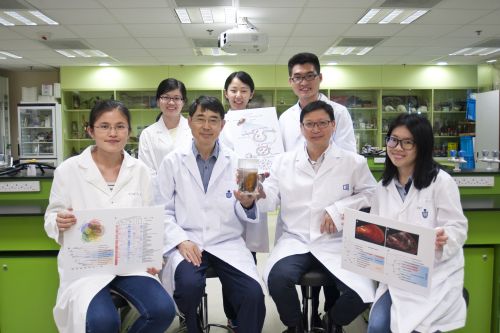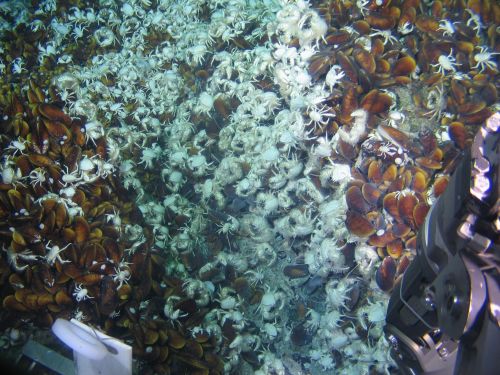|
| Tuesday, 23 May 2017, 23:30 HKT/SGT | |
| |   | |
Source: HKBU / HKUST | |
|
|
|
HONG KONG, May 23, 2017 - (ACN Newswire) - A joint research led by Hong Kong Baptist University (HKBU) and the Hong Kong University of Science and Technology (HKUST) has assembled the 1.64 gigabytes genome of a deep-sea mussel, which is roughly equivalent to 50% of the size of human genome. This is the first decoded genome among all deep-sea macrobenthic animals, revealing a complete set of DNA. The discovery gives wider insights into future research on the mechanisms of symbiosis in other marine organisms such as giant tubeworms and giant clams.
 | | (Front row, second from left) HKUST Professor Pei-Yuan Qian; (front row, third from left) HKBU Dr Jian-Wen Qiu; (back row) HKUST Dr Jin Sun and their team: (front row, left) HKBU Huawei Mu; (front row, right) HKUST Yi Lan; (back row from left) HKBU Yanjie Zhang and Ting Xu. |
 | | (Left) Shell of the deep-sea mussel Bathymodiolus platifrons and (right) shallow-water mussel Modiolus philippinarum. |
 | | Deep-sea mussels viewed from Jiaolong's exploration of a methane seep in the South China Sea. |
The research team, led by HKUST's Chair Professor of Division of Life Science Professor Pei-Yuan Qian and HKBU's Associate Professor of Biology Dr Jian-Wen Qiu, have published the research findings in the prestigious international academic journal Nature Ecology & Evolution in early April.
The team used a specimen collected in 2013 during Dr Qiu's participation in China's manned submersible Jiaolong expedition in the South China Sea for research. Deep-sea organisms including mussels thrive in extreme environments of hydrothermal vents and cold seeps which are characterised by high hydrostatic pressure, lack of photosynthesis-derived food, variable temperatures and high concentrations of toxic substances. Despite their ability to survive under stressful conditions, a lack of genomic resources has hindered the understanding of their molecular mechanisms of adaptation.
The study sequenced the genome of the deep-sea mussel Bathymodiolus platifrons as well as its shallow-water relative Modiolus philippinarum collected from a local softshore in Tingkok for comparison of genomic features. Through phylogenetic analysis, the research team discovered that modern deep-sea mussels are the descendants of shallow-water mussels, and their ancestors migrated to the deep sea approximately 110 million years ago, providing evidence to support a hypothesis that their ancestors survived through an extinction event during the global anoxia period associated with the Palaeocene-Eocene Thermal Maximum which occurred around 57 million years ago.
Genome comparison revealed that the great expansion of several gene families in the deep-sea mussel may be related to its adaptation to the deep sea. For instance, the expansion of the "heat shock protein 70 family", a family of proteins that are produced by a cell in response to exposure to stressful conditions, may help the mussel stabilise protein structures. The expansion of the "ABC transporters family", the unit of the transport system, may enhance the mussel's ability to move toxic chemicals outside its gill epithelial cells.
The expansion of gene families related to immune recognition, endocytosis and caspase-mediated apoptosis indicates the mussel's adaptation to the presence of chemoautotrophic endosymbionts in its gills. An additional proteomic analysis of the deep-sea mussel gill reveals nutritional and energetic dependency of the mussel on its methanotrophic symbionts.
Professor Qian said, "The study has provided genomic resources for understanding how the deep-sea mussel has adapted to the abiotic stresses and lack of photosynthesis-derived food in the deep-sea chemosynthetic environment. The general mechanisms of symbiosis revealed in the study are of relevance to other symbiotic organisms such as deep-sea tubeworms and giant clams."
Dr Qiu said, "The genomic resources will facilitate various studies, including genetic connectivity among deep-sea populations, which is relevant to the establishment of deep-sea marine reserves."
The study was supported by the Strategic Priority Research Program of Chinese Academy of Sciences of China, HKUST, HKBU, Scientific and Technical Innovation Council of Shenzhen, and Guangdong Natural Science Foundation. Other main collaborators are HKUST post-doctoral fellows Dr Jin Sun and Dr Weipeng Zhang, Dr Jerome Hui of The Chinese University of Hong Kong and his team members Wenyan Nong and Fiona Ka Man Cheung, Dr Runsheng Li of Hong Kong Baptist University, Dr Yu Zhang of Shenzhen University, Dr Zhang Yang of The South China Sea Institute of Oceanography, and Christopher Fields of University of Illinois at Urbana-Champaign.
The paper is available online at: http://www.nature.com/articles/s41559-017-0121
A commentary by two independent researchers highlighting the results and significance of this and a related research paper is available at: http://www.nature.com/articles/s41559-017-0142. Those who have no access to this article may request HKBU or HKUST for a copy.
Press release distributed by ResearchSEA for Hong Kong Baptist University.
Topic: Research and development
Source: HKBU / HKUST
Sectors: Materials & Nanotech, Environment, ESG, BioTech, Healthcare & Pharm
http://www.acnnewswire.com
From the Asia Corporate News Network
Copyright © 2025 ACN Newswire. All rights reserved. A division of Asia Corporate News Network.
|
|
|

|
|
|
|